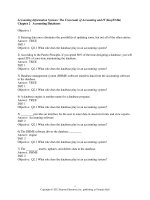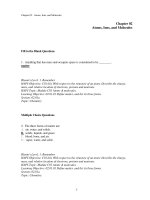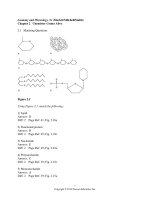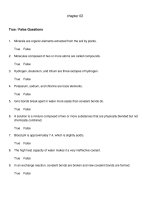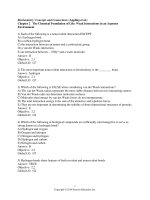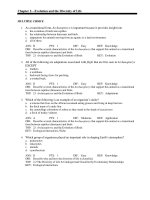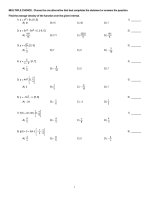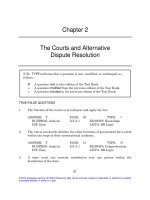Essentials of anatomy and physiology 1st edition saladin test bank
Bạn đang xem bản rút gọn của tài liệu. Xem và tải ngay bản đầy đủ của tài liệu tại đây (89.57 KB, 28 trang )
Chapter 02 - Life, Matter, and Energy
Chapter 02
Life, Matter, and Energy
Multiple Choice Questions
1. (p. 33) The most abundant element in the human body, by weight, is
A. hydrogen.
B. oxygen.
C. calcium.
D. nitrogen.
E. carbon.
Blooms Level: 1. Remember
Learning Outcome: 02.1a Recognize elements of the human body from their chemical
symbols.
Section: 02.01
Topic: Life, Matter, and Energy
2. (p. 33) Sodium has an atomic number of 11 and an atomic mass of 23. Sodium has
A. 12 neutrons and 11 protons.
B. 12 protons and 11 neutrons.
C. 12 electrons and 11 neutrons.
D. 12 protons and 11 electrons.
E. 12 electrons and 11 protons.
Blooms Level: 3. Apply
HAPS Objective: C01.01a Describe the charge, mass, and relative location of electrons,
protons and neutrons
HAPS Topic: Module C01 Atoms & molecules
Learning Outcome: 02.1a Recognize elements of the human body from their chemical
symbols.
Section: 02.01
Topic: Life, Matter, and Energy
2-1
Copyright © 2014 McGraw-Hill Education. All rights reserved. No reproduction or distribution without the prior written consent of
McGraw-Hill Education.
Chapter 02 - Life, Matter, and Energy
3. (p. 33) ______ account for 98.5% of the body's weight.
A. Carbon, oxygen, hydrogen, sodium, potassium, and chlorine
B. Carbon, oxygen, iron, sodium, potassium, and chlorine
C. Carbon, nitrogen, hydrogen, sodium, potassium, and chlorine
D. Carbon, oxygen, hydrogen, nitrogen, sodium, and potassium
E. Carbon, oxygen, hydrogen, nitrogen, calcium, and phosphorus
Blooms Level: 1. Remember
Learning Outcome: 02.1a Recognize elements of the human body from their chemical
symbols.
Section: 02.01
Topic: Life, Matter, and Energy
True / False Questions
4. (p. 36) Molecules composed of two or more atoms are called compounds.
FALSE
Blooms Level: 3. Apply
HAPS Objective: C01.03 Compare and contrast the terms atoms, molecules, elements, and
compounds
HAPS Topic: Module C01 Atoms & molecules
Learning Outcome: 02.1b Distinguish between chemical elements and compounds.
Section: 02.01
Topic: Life, Matter, and Energy
2-2
Copyright © 2014 McGraw-Hill Education. All rights reserved. No reproduction or distribution without the prior written consent of
McGraw-Hill Education.
Chapter 02 - Life, Matter, and Energy
5. (p. 32) Potassium, sodium, and chlorine are trace elements.
FALSE
Blooms Level: 1. Remember
Learning Outcome: 02.1a Recognize elements of the human body from their chemical
symbols.
Section: 02.01
Topic: Life, Matter, and Energy
Multiple Choice Questions
6. (p. 32) The chemical bonding properties of an atom are determined by its
A. protons.
B. electrons.
C. neutrons.
D. protons and neutrons.
E. particles.
Blooms Level: 3. Apply
HAPS Objective: C01.01a Describe the charge, mass, and relative location of electrons,
protons and neutrons
HAPS Topic: Module C01 Atoms & molecules
Learning Outcome: 02.1b Distinguish between chemical elements and compounds.
Section: 02.01
Topic: Life, Matter, and Energy
2-3
Copyright © 2014 McGraw-Hill Education. All rights reserved. No reproduction or distribution without the prior written consent of
McGraw-Hill Education.
Chapter 02 - Life, Matter, and Energy
7. (p. 36) Sodium, which has an atomic number of 11, will react with chlorine, which has an
atomic number of 17. When these two atoms react, both become stable. To become stable,
sodium will ____________, while chlorine will ____________.
A. accept one electron; give up one electron
B. give up one proton; accept one proton
C. share one electron with chlorine; share one electron with sodium
D. become an anion; become a cation
E. give up one electron; accept one electron
Blooms Level: 3. Apply
HAPS Objective: C02.01b Explain the mechanism of each type of bond
HAPS Topic: Module C02 Chemical bonding
Learning Outcome: 02.1f Define the types of chemical bonds.
Section: 02.01
Topic: Life, Matter, and Energy
8. (p. 33) Consider oxygen, which has an atomic number of 8 and an atomic mass of 16. How
many valence electrons does it have?
A. 2
B. 4
C. 6
D. 8
E. 16
Blooms Level: 5. Evaluate
HAPS Objective: C01.01a Describe the charge, mass, and relative location of electrons,
protons and neutrons
HAPS Topic: Module C01 Atoms & molecules
Learning Outcome: 02.1b Distinguish between chemical elements and compounds.
Section: 02.01
Topic: Life, Matter, and Energy
True / False Questions
2-4
Copyright © 2014 McGraw-Hill Education. All rights reserved. No reproduction or distribution without the prior written consent of
McGraw-Hill Education.
Chapter 02 - Life, Matter, and Energy
9. (p. 33) Minerals are organic elements extracted from the soil by plants.
FALSE
Blooms Level: 1. Remember
HAPS Objective: O01.01e List the important dietary minerals and describe the major uses of
each mineral in the body
HAPS Topic: Module O01 Nutrition
Learning Outcome: 02.1c State the functions of minerals in the body.
Section: 02.01
Topic: Life, Matter, and Energy
10. (p. 34) Hydrogen, deuterium, and tritium are three isotopes of hydrogen.
TRUE
Blooms Level: 1. Remember
HAPS Objective: C01.02 Compare and contrast the terms ions, electrolytes, free radicals,
isotopes and radioisotopes
HAPS Topic: Module C01 Atoms & molecules
Learning Outcome: 02.1d Explain the basis for radioactivity and the types and hazards of
ionizing radiation.
Section: 02.01
Topic: Life, Matter, and Energy
Multiple Choice Questions
2-5
Copyright © 2014 McGraw-Hill Education. All rights reserved. No reproduction or distribution without the prior written consent of
McGraw-Hill Education.
Chapter 02 - Life, Matter, and Energy
11. (p. 34) Varieties of elements called ________ differ from one another only in number of
neutrons, and therefore differ in atomic mass.
A. cations
B. anions
C. isotopes
D. electrolytes
E. free radicals
Blooms Level: 1. Remember
HAPS Objective: C01.02 Compare and contrast the terms ions, electrolytes, free radicals,
isotopes and radioisotopes
HAPS Topic: Module C01 Atoms & molecules
Learning Outcome: 02.1d Explain the basis for radioactivity and the types and hazards of
ionizing radiation.
Section: 02.01
Topic: Life, Matter, and Energy
Check All That Apply Questions
12. (p. 34) Which of these is a cation? Check all that apply.
_____ O2
__X__ K+
__X__ Na+
__X__ Ca2+
_____ Cl-
Blooms Level: 2. Understand
HAPS Objective: C01.01c Explain how ions and isotopes are produced by changing the
relative number of specific subatomic particles
HAPS Topic: Module C01 Atoms & molecules
Learning Outcome: 02.1e Distinguish between ions, electrolytes, and free radicals.
Section: 02.01
Topic: Life, Matter, and Energy
2-6
Copyright © 2014 McGraw-Hill Education. All rights reserved. No reproduction or distribution without the prior written consent of
McGraw-Hill Education.
Chapter 02 - Life, Matter, and Energy
True / False Questions
13. (p. 36) Ionic bonds break apart in water more easily than covalent bonds.
TRUE
Blooms Level: 2. Understand
HAPS Objective: C02.01b Explain the mechanism of each type of bond
HAPS Topic: Module C02 Chemical bonding
Learning Outcome: 02.1f Define the types of chemical bonds.
Section: 02.01
Topic: Life, Matter, and Energy
Multiple Choice Questions
14. (p. 36) Oxygen has an atomic number of eight. When two oxygen atoms come together,
they form a(n) __________ bond.
A. hydrogen
B. nonpolar covalent
C. polar covalent
D. ionic
E. Van der Waals
Blooms Level: 3. Apply
HAPS Objective: C02.01b Explain the mechanism of each type of bond
HAPS Topic: Module C02 Chemical bonding
Learning Outcome: 02.1f Define the types of chemical bonds.
Section: 02.01
Topic: Life, Matter, and Energy
2-7
Copyright © 2014 McGraw-Hill Education. All rights reserved. No reproduction or distribution without the prior written consent of
McGraw-Hill Education.
Chapter 02 - Life, Matter, and Energy
15. (p. 36) When table salt, sodium chloride (NaCl), is placed in water
A. Na+ and Cl- form ionic bonds with each other.
B. Na+ and Cl- form polar covalent bonds with each other.
C. Na+ and Cl- form hydrogen bonds with water.
D. ionic bonds between Na+ and Cl- are broken.
E. Na+ and Cl- become separated by their Van der Waals forces.
Blooms Level: 3. Apply
HAPS Objective: C02.01b Explain the mechanism of each type of bond
HAPS Topic: Module C02 Chemical bonding
Learning Outcome: 02.1f Define the types of chemical bonds.
Section: 02.01
Topic: Life, Matter, and Energy
16. (p. 34) The bonding properties of an atom are determined by its
A. electrons.
B. protons.
C. positrons.
D. neutrons.
E. photons.
Blooms Level: 2. Understand
HAPS Objective: C02.01b Explain the mechanism of each type of bond
HAPS Topic: Module C02 Chemical bonding
Learning Outcome: 02.1f Define the types of chemical bonds.
Section: 02.01
Topic: Life, Matter, and Energy
2-8
Copyright © 2014 McGraw-Hill Education. All rights reserved. No reproduction or distribution without the prior written consent of
McGraw-Hill Education.
Chapter 02 - Life, Matter, and Energy
17. (p. 36) What type of bond attracts one water molecule to another?
A. An ionic bond
B. A peptide bond
C. A hydrogen bond
D. A covalent bond
E. A hydrolytic bond
Blooms Level: 1. Remember
HAPS Objective: C02.01b Explain the mechanism of each type of bond
HAPS Topic: Module C02 Chemical bonding
Learning Outcome: 02.1f Define the types of chemical bonds.
Section: 02.01
Topic: Life, Matter, and Energy
True / False Questions
18. (p. 39) The high heat capacity of water makes it a very ineffective coolant.
FALSE
Blooms Level: 2. Understand
HAPS Objective: C03.01 Discuss the physiologically important properties of water
HAPS Topic: Module C03 Inorganic compounds & solutions
Learning Outcome: 02.2a Describe the biologically important properties of water.
Section: 02.02
Topic: Life, Matter, and Energy
Multiple Choice Questions
2-9
Copyright © 2014 McGraw-Hill Education. All rights reserved. No reproduction or distribution without the prior written consent of
McGraw-Hill Education.
Chapter 02 - Life, Matter, and Energy
19. (p. 39) When you jump off a high diving board into water, you notice the great resistance
of water. This resistance is called __________ and is caused by water's great ______.
A. surface tension; adhesiveness
B. surface tension; cohesiveness
C. hydrophobic tension; adhesiveness
D. hydrophilic tension; cohesiveness
E. hydrophilic tension; adhesiveness
Blooms Level: 3. Apply
HAPS Objective: C03.01 Discuss the physiologically important properties of water
HAPS Topic: Module C03 Inorganic compounds & solutions
Learning Outcome: 02.2a Describe the biologically important properties of water.
Section: 02.02
Topic: Life, Matter, and Energy
20. (p. 39) Which of these is hydrophobic?
A. Sugar
B. K+
C. ClD. Water
E. Fat
Blooms Level: 3. Apply
HAPS Objective: C03.01 Discuss the physiologically important properties of water
HAPS Topic: Module C03 Inorganic compounds & solutions
Learning Outcome: 02.2a Describe the biologically important properties of water.
Section: 02.02
Topic: Life, Matter, and Energy
True / False Questions
2-10
Copyright © 2014 McGraw-Hill Education. All rights reserved. No reproduction or distribution without the prior written consent of
McGraw-Hill Education.
Chapter 02 - Life, Matter, and Energy
21. (p. 40) A solution is a mixture composed of two or more substances that are physically
blended but not chemically combined.
TRUE
Blooms Level: 2. Understand
HAPS Objective: C03.02 Distinguish among the terms solution, solute, solvent, colloid
suspension, and emulsion
HAPS Topic: Module C03 Inorganic compounds & solutions
Learning Outcome: 02.2b Define mixture and distinguish between three types of mixtures
Section: 02.02
Topic: Life, Matter, and Energy
Multiple Choice Questions
22. (p. 40) Consider a mixture of blood, which contains sodium chloride, protein, and cells or
formed elements. The sodium chloride is in a(n) ____________, the protein is in a(n)
__________, and the cells are in a ____________.
A. emulsion; solution; suspension
B. solvent; emulsion; colloid
C. colloid; suspension; solution
D. suspension; colloid; solution
E. solution; colloid; suspension
Blooms Level: 3. Apply
HAPS Objective: C03.02 Distinguish among the terms solution, solute, solvent, colloid
suspension, and emulsion
HAPS Topic: Module C03 Inorganic compounds & solutions
Learning Outcome: 02.2b Define mixture and distinguish between three types of mixtures
Section: 02.02
Topic: Life, Matter, and Energy
True / False Questions
2-11
Copyright © 2014 McGraw-Hill Education. All rights reserved. No reproduction or distribution without the prior written consent of
McGraw-Hill Education.
Chapter 02 - Life, Matter, and Energy
23. (p. 41) Blood pH is approximately 7.4, which is slightly acidic.
FALSE
Blooms Level: 1. Remember
HAPS Objective: C03.04 Define the terms pH, acid, base, and buffer and give examples of
physiological significance
HAPS Topic: Module C03 Inorganic compounds & solutions
Learning Outcome: 02.2c Define acid and base and interpret the pH scale.
Section: 02.02
Topic: Life, Matter, and Energy
Multiple Choice Questions
24. (p. 41) A solution with pH 4 has ______ the H+ concentration of a solution with pH 8.
A. half
B. twice
C. 4 times
D. 10,000 times
E. 1/10,000
Blooms Level: 5. Evaluate
HAPS Objective: C03.04 Define the terms pH, acid, base, and buffer and give examples of
physiological significance
HAPS Topic: Module C03 Inorganic compounds & solutions
Learning Outcome: 02.2c Define acid and base and interpret the pH scale.
Section: 02.02
Topic: Life, Matter, and Energy
2-12
Copyright © 2014 McGraw-Hill Education. All rights reserved. No reproduction or distribution without the prior written consent of
McGraw-Hill Education.
Chapter 02 - Life, Matter, and Energy
25. (p. 41) Which of these has the highest H+ concentration?
A. Lemon juice, pH = 2.3
B. Red wine, pH = 3.2
C. Tomato juice, pH = 4.7
D. Saliva, pH = 6.6
E. Household ammonia, pH = 10.8
Blooms Level: 3. Apply
HAPS Objective: C03.04 Define the terms pH, acid, base, and buffer and give examples of
physiological significance
HAPS Topic: Module C03 Inorganic compounds & solutions
Learning Outcome: 02.2c Define acid and base and interpret the pH scale.
Section: 02.02
Topic: Life, Matter, and Energy
26. (p. 41) Blood has a pH ranging from 7.35 to 7.45. Slight deviations from this can cause
major problems or even death. You are doing an intense workout, and your skeletal muscle
cells are producing metabolic acids such as lactic acid. Your blood pH does not drop
significantly in spite of the metabolic acids released into the blood. You maintain a constant
blood pH because
A. metabolic acids are neutralized in muscle cells before being released into the blood.
B. metabolic bases are produced at the same rate by muscle cells to neutralize the acids.
C. the respiratory system removes excess H+ from the blood before the pH is lowered.
D. the body contains chemicals called buffers that resist changes in pH.
E. endothelial cells secrete excess H+ to prevent a decrease in pH.
Blooms Level: 5. Evaluate
HAPS Objective: C03.04 Define the terms pH, acid, base, and buffer and give examples of
physiological significance
HAPS Topic: Module C03 Inorganic compounds & solutions
Learning Outcome: 02.2c Define acid and base and interpret the pH scale.
Section: 02.02
Topic: Life, Matter, and Energy
2-13
Copyright © 2014 McGraw-Hill Education. All rights reserved. No reproduction or distribution without the prior written consent of
McGraw-Hill Education.
Chapter 02 - Life, Matter, and Energy
27. (p. 41) A solution that resists a change in pH when acid or base is added to it is
A. a buffer.
B. a catalyst.
C. a reducing agent.
D. an oxidizing agent.
E. a colloid.
Blooms Level: 1. Remember
HAPS Objective: C03.04 Define the terms pH, acid, base, and buffer and give examples of
physiological significance
HAPS Topic: Module C03 Inorganic compounds & solutions
Learning Outcome: 02.2c Define acid and base and interpret the pH scale.
Section: 02.02
Topic: Life, Matter, and Energy
28. (p. 56) The most relevant form of energy in human physiology is the energy stored in
A. electrolytes ionized in water.
B. free radicals with an odd number of electrons.
C. radioisotopes.
D. the chemical bonds of organic molecules.
E. Van der Waals forces.
Blooms Level: 3. Apply
HAPS Objective: C05.01 Describe the generalized reversible reaction for release of energy
from ATP and explain the role of ATP in the cell
HAPS Topic: Module C05 Energy transfer using ATP
Learning Outcome: 02.3f Describe the structure, production, and function of ATP.
Section: 02.03
Topic: Life, Matter, and Energy
2-14
Copyright © 2014 McGraw-Hill Education. All rights reserved. No reproduction or distribution without the prior written consent of
McGraw-Hill Education.
Chapter 02 - Life, Matter, and Energy
29. (p. 58) Any chemical reaction that removes electrons from an atom is called
A. reduction.
B. condensation.
C. hydrolysis.
D. anabolism.
E. oxidation.
Blooms Level: 1. Remember
HAPS Objective: O02.05 Describe the processes of oxidation, reduction, decarboxylation,
and phosphorylation
HAPS Topic: Module O02 Introduction to metabolism
Learning Outcome: 02.4d Define oxidation and reduction and relate these to changes in the
energy content of a molecule.
Section: 02.04
Topic: Life, Matter, and Energy
30. (p. 55) When ATP breaks down to ADP, potential energy stored in bonds is released. This
energy stored in bonds is __________ energy.
A. electromagnetic
B. electrical
C. chemical
D. heat
E. kinetic
Blooms Level: 1. Remember
HAPS Objective: C05.01 Describe the generalized reversible reaction for release of energy
from ATP and explain the role of ATP in the cell
HAPS Topic: Module C05 Energy transfer using ATP
Learning Outcome: 02.3f Describe the structure, production, and function of ATP.
Section: 02.03
Topic: Life, Matter, and Energy
2-15
Copyright © 2014 McGraw-Hill Education. All rights reserved. No reproduction or distribution without the prior written consent of
McGraw-Hill Education.
Chapter 02 - Life, Matter, and Energy
31. (p. 57) Which of the following equations depicts an exchange reaction?
A. AB A + B
B. A + B AB
C. AB + CD AC + BD
D. AB A- + B+
E. A + B AB C + D
Blooms Level: 2. Understand
Learning Outcome: 02.4b List and define the fundamental types of chemical reactions.
Section: 02.04
Topic: Life, Matter, and Energy
True / False Questions
32. (p. 57) In an exchange reaction, covalent bonds are broken and new covalent bonds are
formed.
TRUE
Blooms Level: 5. Evaluate
Learning Outcome: 02.4b List and define the fundamental types of chemical reactions.
Section: 02.04
Topic: Life, Matter, and Energy
2-16
Copyright © 2014 McGraw-Hill Education. All rights reserved. No reproduction or distribution without the prior written consent of
McGraw-Hill Education.
Chapter 02 - Life, Matter, and Energy
33. (p. 43) The opposite of a dehydration synthesis is hydrolysis.
TRUE
Blooms Level: 1. Remember
HAPS Objective: C04.03 Define and give examples of dehydration synthesis and hydrolysis
reactions
HAPS Topic: Module C04 Organic compounds
Learning Outcome: 02.3a Discuss the relevance of polymers to biology and explain how they
are formed and broken by dehydration synthesis and hydrolysis.
Section: 02.03
Topic: Life, Matter, and Energy
Multiple Choice Questions
34. (p. 58) Any chemical reaction in which an atom gains electrons is called
A. reduction.
B. condensation.
C. hydrolysis.
D. anabolism.
E. oxidation.
Blooms Level: 1. Remember
HAPS Objective: O02.05 Describe the processes of oxidation, reduction, decarboxylation,
and phosphorylation
HAPS Topic: Module O02 Introduction to metabolism
Learning Outcome: 02.4d Define oxidation and reduction and relate these to changes in the
energy content of a molecule.
Section: 02.04
Topic: Life, Matter, and Energy
2-17
Copyright © 2014 McGraw-Hill Education. All rights reserved. No reproduction or distribution without the prior written consent of
McGraw-Hill Education.
Chapter 02 - Life, Matter, and Energy
35. (p. 58) The breakdown of glycogen (an energy-storage compound) is an example of a(n)
______ reaction.
A. exergonic
B. endergonic
C. exchange
D. synthesis
E. equilibrium
Blooms Level: 2. Understand
HAPS Objective: O02.01 Define metabolism, anabolism and catabolism
HAPS Topic: Module O02 Introduction to metabolism
Learning Outcome: 02.4c Define metabolism and its two subdivisions.
Section: 02.04
Topic: Life, Matter, and Energy
36. (p. 58) Digestive enzymes break down the starch in a potato into thousands of glucose
molecules. This exemplifies a(n) ______ reaction.
A. synthesis
B. decomposition
C. exchange
D. anabolic
E. reductive
Blooms Level: 2. Understand
HAPS Objective: O02.01 Define metabolism, anabolism and catabolism
HAPS Topic: Module O02 Introduction to metabolism
Learning Outcome: 02.4c Define metabolism and its two subdivisions.
Section: 02.04
Topic: Life, Matter, and Energy
True / False Questions
2-18
Copyright © 2014 McGraw-Hill Education. All rights reserved. No reproduction or distribution without the prior written consent of
McGraw-Hill Education.
Chapter 02 - Life, Matter, and Energy
37. (p. 58) All the chemical reactions in which larger molecules are broken down to smaller
ones are called catabolic reactions.
TRUE
Blooms Level: 1. Remember
HAPS Objective: O02.01 Define metabolism, anabolism and catabolism
HAPS Topic: Module O02 Introduction to metabolism
Learning Outcome: 02.4c Define metabolism and its two subdivisions.
Section: 02.04
Topic: Life, Matter, and Energy
Multiple Choice Questions
38. (p. 58) Glucose is broken down in most of your cells to form carbon dioxide, oxygen, and
the energy currency of the cell called ATP. This type of reaction is both _________ and
___________.
A. anabolic; endergonic
B. catabolic; exergonic
C. anabolic; exergonic
D. catabolic; endergonic
E. anabolic; exothermic
Blooms Level: 3. Apply
HAPS Objective: O02.01 Define metabolism, anabolism and catabolism
HAPS Topic: Module O02 Introduction to metabolism
Learning Outcome: 02.4c Define metabolism and its two subdivisions.
Section: 02.04
Topic: Life, Matter, and Energy
2-19
Copyright © 2014 McGraw-Hill Education. All rights reserved. No reproduction or distribution without the prior written consent of
McGraw-Hill Education.
Chapter 02 - Life, Matter, and Energy
39. (p. 58) Which of the following words includes all of the other terms?
A. Catabolism
B. Anabolism
C. Metabolism
D. Oxidative reactions
E. Reductive reactions
Blooms Level: 3. Apply
HAPS Objective: O02.01 Define metabolism, anabolism and catabolism
HAPS Topic: Module O02 Introduction to metabolism
Learning Outcome: 02.4c Define metabolism and its two subdivisions.
Section: 02.04
Topic: Life, Matter, and Energy
40. (p. 43) A ______ reaction converts a ______ to its monomers.
A. hydrolysis; polymer
B. dehydration synthesis; molecule
C. dehydration synthesis; polymer
D. polymer; molecule
E. condensation; reactant
Blooms Level: 3. Apply
HAPS Objective: C04.03 Define and give examples of dehydration synthesis and hydrolysis
reactions
HAPS Topic: Module C04 Organic compounds
Learning Outcome: 02.3a Discuss the relevance of polymers to biology and explain how they
are formed and broken by dehydration synthesis and hydrolysis.
Section: 02.03
Topic: Life, Matter, and Energy
2-20
Copyright © 2014 McGraw-Hill Education. All rights reserved. No reproduction or distribution without the prior written consent of
McGraw-Hill Education.
Chapter 02 - Life, Matter, and Energy
41. (p. 44) ______ is a monosaccharide, whereas ______ is a polysaccharide.
A. Fructose; sucrose
B. Galactose; maltose
C. Lactose; glycogen
D. Glucose; starch
E. Cellulose; glucose
Blooms Level: 3. Apply
HAPS Objective: C04.04b Compare and contrast general molecular structure
HAPS Topic: Module C04 Organic compounds
Learning Outcome: 02.3c Describe or define the subclasses of each of those categories of
biomolecules.
Section: 02.03
Topic: Life, Matter, and Energy
42. (p. 44) Which of the following is a disaccharide?
A. Galactose
B. Lactose
C. Glucose
D. Fructose
E. Amylose
Blooms Level: 1. Remember
HAPS Objective: C04.04c Provide specific examples (of organic molecules)
HAPS Topic: Module C04 Organic compounds
Learning Outcome: 02.3c Describe or define the subclasses of each of those categories of
biomolecules.
Section: 02.03
Topic: Life, Matter, and Energy
2-21
Copyright © 2014 McGraw-Hill Education. All rights reserved. No reproduction or distribution without the prior written consent of
McGraw-Hill Education.
Chapter 02 - Life, Matter, and Energy
43. (p. 44) Table sugar is a disaccharide called __________ and is made up of the
monomer(s) __________.
A. maltose; glucose
B. sucrose; glucose and fructose
C. lactose; glucose and galactose
D. glycogen; glucose
E. glucose; galactose and fructose
Blooms Level: 1. Remember
HAPS Objective: C04.04c Provide specific examples (of organic molecules)
HAPS Topic: Module C04 Organic compounds
Learning Outcome: 02.3c Describe or define the subclasses of each of those categories of
biomolecules.
Section: 02.03
Topic: Life, Matter, and Energy
True / False Questions
44. (p. 45) Unsaturated fatty acids have as much hydrogen as they can carry.
FALSE
Blooms Level: 2. Understand
HAPS Objective: C04.04c Provide specific examples (of organic molecules)
HAPS Topic: Module C04 Organic compounds
Learning Outcome: 02.3c Describe or define the subclasses of each of those categories of
biomolecules.
Section: 02.03
Topic: Life, Matter, and Energy
Multiple Choice Questions
2-22
Copyright © 2014 McGraw-Hill Education. All rights reserved. No reproduction or distribution without the prior written consent of
McGraw-Hill Education.
Chapter 02 - Life, Matter, and Energy
45. (p. 45) Triglycerides are molecules consisting of one 3-carbon compound called ________
bound to three ________.
A. eicosanoid; fatty acids
B. steroid; glycerols
C. eicosanoid; steroid
D. glycerol; fatty acids
E. steroid; fatty acids
Blooms Level: 1. Remember
HAPS Objective: C04.04b Compare and contrast general molecular structure
HAPS Topic: Module C04 Organic compounds
Learning Outcome: 02.3b Describe the structural properties that distinguish carbohydrates,
lipids, proteins, and nucleic acids from each other
Section: 02.03
Topic: Life, Matter, and Energy
True / False Questions
46. (p. 49) A dipeptide is a molecule with two peptide bonds.
FALSE
Blooms Level: 1. Remember
HAPS Objective: C04.04b Compare and contrast general molecular structure
HAPS Topic: Module C04 Organic compounds
Learning Outcome: 02.3c Describe or define the subclasses of each of those categories of
biomolecules.
Section: 02.03
Topic: Life, Matter, and Energy
Multiple Choice Questions
2-23
Copyright © 2014 McGraw-Hill Education. All rights reserved. No reproduction or distribution without the prior written consent of
McGraw-Hill Education.
Chapter 02 - Life, Matter, and Energy
47. (p. 49) Proteins can serve all of the following functions except
A. catalyze metabolic reactions.
B. give structural strength to cells and tissues.
C. produce muscular and other forms of movement.
D. regulate transport of solutes into and out of cells.
E. store hereditary information.
Blooms Level: 1. Remember
HAPS Objective: C04.04e Discuss physiological and structural roles in the human body
HAPS Topic: Module C04 Organic compounds
Learning Outcome: 02.3d Discuss the roles that each of these categories of molecules play in
the body.
Section: 02.03
Topic: Life, Matter, and Energy
48. (p. 51) A drastic conformational change in proteins in response to conditions such as
extreme heat or pH will lead to loss of a protein's function. This drastic change in threedimensional shape is called
A. contamination.
B. denaturation.
C. saturation.
D. sedimentation.
E. deconformation.
Blooms Level: 1. Remember
HAPS Objective: C04.06 Demonstrate factors that affect enzyme activity, including
denaturation, and interpret graphs showing the effects of various factors on the rate of
enzyme catalyzed reactions
HAPS Topic: Module C04 Organic compounds
Learning Outcome: 02.3d Discuss the roles that each of these categories of molecules play in
the body.
Section: 02.03
Topic: Life, Matter, and Energy
2-24
Copyright © 2014 McGraw-Hill Education. All rights reserved. No reproduction or distribution without the prior written consent of
McGraw-Hill Education.
Chapter 02 - Life, Matter, and Energy
49. (p. 49) Proteins are ______ built from ______ different amino acids.
A. monomers; 10
B. molecules; 10
C. polymers; 20
D. macromolecules; 40
E. polypeptides; 80
Blooms Level: 1. Remember
HAPS Objective: C04.04b Compare and contrast general molecular structure
HAPS Topic: Module C04 Organic compounds
Learning Outcome: 02.3b Describe the structural properties that distinguish carbohydrates,
lipids, proteins, and nucleic acids from each other
Section: 02.03
Topic: Life, Matter, and Energy
50. (p. 52) Enzymes are specific to substrates because of the shape of their
A. active sites.
B. receptors.
C. secondary structure.
D. terminal amino acids.
E. alpha chain.
Blooms Level: 1. Remember
HAPS Objective: C04.06 Demonstrate factors that affect enzyme activity, including
denaturation, and interpret graphs showing the effects of various factors on the rate of
enzyme catalyzed reactions
HAPS Topic: Module C04 Organic compounds
Learning Outcome: 02.3e Explain how enzymes function.
Section: 02.03
Topic: Life, Matter, and Energy
2-25
Copyright © 2014 McGraw-Hill Education. All rights reserved. No reproduction or distribution without the prior written consent of
McGraw-Hill Education.
